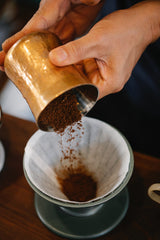The Difference In Freshly Ground Coffee

Coffee lovers understand the significance of freshly ground coffee in achieving the perfect cup of joe. The process of grinding coffee beans plays a crucial role in enhancing the flavor and aroma of the final brew.
This article delves into the importance of freshly ground coffee, exploring how it enhances flavor by preserving aromatic oils and discussing various techniques for grinding coffee at home.
Freshly ground coffee is essential for unlocking the full potential of the beans and experiencing the true flavors they offer. When coffee beans are ground, they release a plethora of aromatic oils that contribute to the overall taste and aroma of the brew. These oils are delicate, volatile compounds that can quickly dissipate if not utilized promptly. By grinding coffee just before brewing, these precious oils are preserved, resulting in a more flavorful and aromatic cup of coffee.
Grinding your beans freshly also allows for greater control over the grind size, enabling coffee enthusiasts to experiment with different brewing methods and extract the desired flavors from the beans. Whether it's a fine grind for espresso or a coarse grind for French press, the grind size can greatly impact the taste and strength of the coffee. Thus, understanding the different grind sizes and methods becomes crucial in achieving the perfect cup of freshly ground coffee.
The Importance of Freshly Ground Coffee
The significance of using freshly ground coffee lies in its ability to enhance the overall flavor and aroma of the brewed beverage. When coffee beans are freshly ground, the surface area increases, allowing for more efficient extraction of the flavors and oils locked within the beans. This results in a richer, more robust cup of coffee that is bursting with complex flavors and enticing aromas.
The process of grinding coffee beans releases volatile compounds that contribute to the aromatic profile of the final brew. The enticing scent of freshly ground coffee is often described as earthy, nutty, or even fruity, depending on the origin of the beans.
These aromatic compounds are quickly lost once the coffee beans are ground, so using freshly ground coffee ensures that the full bouquet of flavors and aromas is preserved and enjoyed in every sip.
In addition to enhancing the sensory experience, freshly ground coffee also allows for greater control over the brewing process. The grind size plays a crucial role in determining the extraction rate and overall flavor profile of the coffee. By grinding the coffee beans just before brewing, one can adjust the grind size to match the brewing method and personal preference.
For example, a coarser grind is typically used for French press, while a finer grind is necessary for espresso. This level of control ensures that the coffee is brewed to perfection, resulting in a cup that is tailored to one's individual taste preferences.
Freshly ground coffee retains its natural oils, which contribute to a fuller body and a silky texture in the brewed beverage. These oils add depth and complexity to the coffee, elevating it from a mere morning pick-me-up to a truly indulgent and satisfying experience.
Enhancing Flavor with Freshly Ground Beans
Enhancing the flavor of coffee can be achieved by utilizing freshly ground beans. When coffee beans are ground shortly before brewing, the flavors and aromas are at their peak, resulting in a more vibrant and enjoyable cup of coffee.
Here are four reasons why freshly ground beans can enhance the flavor of coffee:
- Preservation of Aromas: Coffee beans contain volatile compounds that give coffee its distinct aroma. When beans are ground, these compounds are released into the air, making the coffee more fragrant. By grinding the beans just before brewing, the aromas are preserved, ensuring that the coffee has a more intense and enticing smell.
- Maximized Surface Area: Grinding coffee beans increases their surface area, allowing for better extraction of flavor during brewing. The increased surface area exposes more of the coffee's oils and compounds to hot water, resulting in a fuller-bodied and more flavorful cup of coffee.
- Consistency of Particle Size: Grinding coffee beans allows for more control over the size of the particles. Consistency in particle size is crucial for an even extraction during brewing. When the particles are uniform, each coffee ground is exposed to the same amount of water, ensuring a balanced and well-extracted cup of coffee.
- Freshness Retention: Coffee beans contain oils and volatile compounds that begin to degrade as soon as they are exposed to air. By grinding the beans just before brewing, the freshness of these compounds is retained, resulting in a more vibrant and flavorful cup of coffee.
Using freshly ground beans can greatly enhance the flavor of coffee. The preservation of aromas, maximized surface area, consistency of particle size, and freshness retention all contribute to a more flavorful and enjoyable coffee experience.
So, if you want to elevate your coffee's taste, investing in a good quality grinder and grinding your beans just before brewing is definitely worth considering.
Preserving Aromatic Oils in Your Brew
Preserving aromatic oils in the brew involves carefully maintaining the integrity of the volatile compounds that contribute to the coffee's distinct fragrance. These oils contain a myriad of complex compounds that are responsible for the captivating aroma that wafts from a freshly brewed cup of coffee. When the beans are ground, these aromatic oils are released, and their preservation becomes crucial in order to enhance the overall flavor experience. The volatile compounds are easily lost due to exposure to air, heat, light, and moisture, which can result in a dull and lackluster cup of coffee. To prevent this, it is essential to store the coffee beans in airtight containers away from direct sunlight, heat, and moisture. Additionally, grinding the beans just before brewing can help preserve the aromatic oils, as they are more susceptible to degradation once exposed to the air. By carefully preserving these oils, coffee enthusiasts can ensure a truly aromatic and flavorful cup of coffee.
To better understand the significance of preserving aromatic oils, let's explore a table that highlights the impact of these oils on the overall coffee experience:
By preserving these aromatic oils, the coffee not only retains its enticing aroma but also elevates the taste experience. Each volatile compound contributes unique characteristics that combine to create a harmonious and memorable cup of coffee. As coffee lovers, it is essential to appreciate and preserve these aromatic oils to fully savor the complexity and richness they bring to our daily brew.
Techniques for Grinding Coffee at Home
To achieve optimal flavor extraction, mastering the art of grinding coffee at home is essential.
The process of grinding coffee beans plays a crucial role in unlocking the rich aromas and flavors hidden within. When coffee beans are ground, their surface area increases, allowing for more efficient extraction of oils and solubles during brewing. This results in a more flavorful and aromatic cup of coffee.
The key to achieving the perfect grind lies in understanding the different techniques available and selecting the one that best suits your brewing method.
One popular technique for grinding coffee at home is using a burr grinder. This type of grinder allows for precise control over the size of the coffee grounds, leading to a more consistent and even extraction. Burr grinders work by crushing the coffee beans between two revolving abrasive surfaces, ensuring that the particles are uniformly ground. This technique is particularly beneficial for pour-over brewing methods, where a medium to fine grind size is desired.
On the other hand, blade grinders, which use a spinning blade to chop the beans, can be a more affordable option. However, they often produce uneven grounds, resulting in an inconsistent extraction. Nevertheless, blade grinders can still be suitable for brewing methods that require a coarser grind, such as the French press.
Whichever technique you choose, it is important to invest in a high-quality grinder that allows for adjustable grind settings, as this will give you the flexibility to tailor your grind size to your preferred brewing method.
Grinding coffee at home is an art that requires attention to detail and an understanding of the different techniques available. By selecting the right grinder and grind size for your brewing method, you can unlock the full potential of your coffee beans, resulting in a superior cup of coffee.
Experimenting with different grind sizes and techniques will allow you to find the perfect balance that suits your taste preferences. So, embark on this journey of exploration and elevate your coffee experience by mastering the art of grinding coffee at home.
Exploring Different Grind Sizes and Methods
Exploring the diverse terrain of grind sizes and methods is like embarking on a captivating journey through the intricate flavors and aromas of the coffee world. Each grind size and method has its own unique characteristics that contribute to the overall taste and quality of the coffee. From coarse grind for French press to fine grind for espresso, the possibilities are endless.
- Coarse grind: This grind size is typically used for the French press, where the coffee grounds are steeped in water for a longer period of time. The resulting brew is bold and full-bodied, with a rich and robust flavor.
- Medium grind: This versatile grind size is commonly used for drip coffee makers or pour-over methods. It strikes a balance between the boldness of coarse grind and the smoothness of fine grind, resulting in a well-rounded and flavorful cup of coffee.
- Fine grind: This grind size is essential for espresso machines, where the water is forced through finely packed coffee grounds under high pressure. The result is a concentrated and intense shot of coffee, with a thick layer of crema on top.
- Extra-fine grind: This grind size is typically used for Turkish coffee, where the coffee grounds are boiled in water. The resulting brew is strong and full-bodied, with a distinctive and rich flavor.
As you navigate through the different grind sizes and methods, you will discover the nuances and subtleties that each one brings to the table. Whether you prefer a bold and robust cup of coffee or a smooth and delicate brew, there is a grind size and method that can cater to your taste preferences.
So, grab your grinder and embark on this exciting journey of exploring the world of freshly ground coffee.
What a Difference Fresh Makes
Freshly ground coffee is essential for a truly exceptional cup of Joe. By grinding coffee beans just before brewing, you unlock a world of flavors and aromas that are otherwise lost.
The process of grinding breaks down the beans, releasing the aromatic oils that give coffee its distinct taste. This preservation of oils significantly enhances the flavor profile of your brew, resulting in a richer, more satisfying experience.
Grinding coffee at home allows you to experiment with various grind sizes and methods, tailoring each cup to your preference. Whether you prefer a coarse grind for a French press or a fine grind for an espresso machine, the possibilities are endless.
Each brewing method extracts different flavors from the coffee grounds, and by grinding your own beans, you have the power to create a truly personalized coffee experience.
So, why settle for pre-ground coffee when you can indulge in the divine experience of freshly ground beans? Imagine waking up to the enticing aroma of a perfectly brewed cup of coffee, with flavors that dance on your taste buds.
The precision and control of grinding your own coffee allow you to unlock the full potential of each bean, resulting in a cup that is unmatched in taste and quality. Don't deny yourself this sensory pleasure; embrace the art of grinding coffee at home and elevate your coffee experience to new heights.







